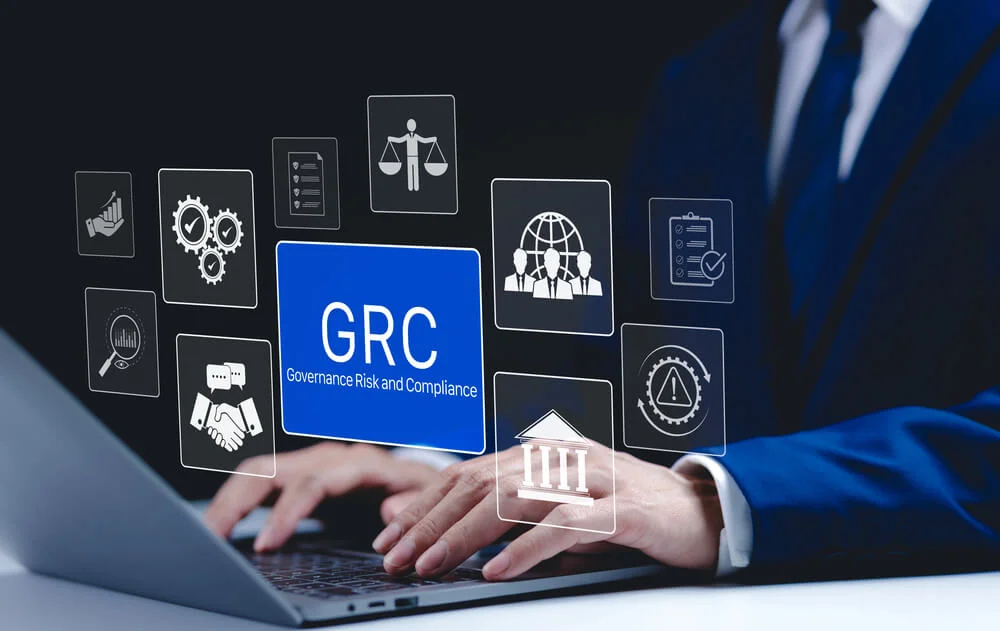In today’s complex digital arena, businesses of all sizes face mounting cybersecurity threats. Understanding the interconnected concepts of risk vs. threat vs. vulnerability is the foundation for building a strong defense strategy.
To safeguard your organization against the potentially devastating consequences of a cyberattack, you must understand these critical concepts and how they relate to risk management and cybersecurity.
What Is the Difference Between Vulnerability, Risk, and Threat?

Risks, threats, and vulnerabilities have important differences and present unique challenges. Organizations must understand the relationship between each stage to construct effective cybersecurity defenses.
| 1. Vulnerability > 2. Threat > 3.Risk | |||
| Vulnerability | Threat | Risk | |
| Definition | System weakness or flaw | Harmful events, individuals, or groups | Possible losses or damages |
| Examples | Configuration errorsUnpatched softwarePoor cybersecurity habitsCareless employees | HackersRansomwareCyber warfareDDoS attacksFloods | Financial lossesStolen dataFinesLost customers |
| Statistics | Nearly 90% of all data breaches are caused by human error. | There were 70% more data breaches in 2023 than the previous record | A single data breach costs over $4.5 million on average |
| Solutions | Vulnerability assessmentsEmployee trainingCorrective actions | Strong cybersecurity policiesAccess controlMobile device securityNetwork monitoring | Risk prioritizationBreach mitigation strategiesData loss preventionCybersecurity management platform |
What Is a Vulnerability?
A vulnerability is a weakness or flaw within a system, asset, or process that a threat actor can exploit to cause harm or compromise security. It represents a potential entry point for various threat actors and risks the integrity of the affected organization. There are three main types of vulnerabilities: technical, process-based, and human.
Technical Vulnerabilities
Technical vulnerabilities are weaknesses in software, hardware, or network configurations. Examples of technical vulnerabilities include:
- Unpatched software
- Misconfigured firewalls or network devices
- Outdated operating systems no longer supported by security updates
- Inherent flaws discovered in older hardware (e.g., IoT devices and routers)
These vulnerabilities affect every industry, from manufacturing to healthcare.
Process-Based Vulnerabilities
Process-based vulnerabilities are problems in an organization’s policies, processes, or procedures. Common examples of this type of vulnerability include:
- Inadequate password management policies
- Failure to educate employees on email security best practices
- Poor incident response plans
- Insufficient vendor security assessments
- Lack of acceptable use policies for mobile devices
Outdated organizational policies can create data silos that are especially vulnerable to hackers. Poor communication and lack of departmental oversight are a recipe for disaster.
Human Vulnerabilities
Human vulnerabilities are system weaknesses stemming from a company’s workers, including managers and executives:
- Human error: Leaks from mishandling sensitive information, like sending confidential emails to the wrong person
- Poor awareness: Leaving a network-enabled mobile device unattended
- Social engineering: Employees falling for phishing scams
- Carelessness: Sharing passwords with outside parties, using weak passwords, or storing passwords in full view
- Insider threats: Theft of data by disgruntled employees or workers bribed by external actors
The vulnerability landscape is ever-changing and attack surfaces can exist at multiple business levels. Performing ongoing vulnerability assessments is important because detecting and correcting critical vulnerabilities can prevent massive threats.
What Is a Threat?

Next in the chain of threat vs. vulnerability vs. risk is a threat. Threats are possible events, individuals, or organizations that intend to exploit a vulnerability. The impact on organizations varies depending on the nature of the threat:
- Network disruption
- Equipment downtime, malfunctions, or permanent damage
- Unauthorized system access and lockdowns (e.g, ransomware encryption)
- Data breaches
- Physical harm to workers, patients, etc.
Threats can come from a wide variety of sources, have a broad range of goals or purposes, and use many different methods to reach their objectives.
Cybercriminals
Cybercriminals target businesses, individuals, and organizations. The primary motivation is financial gain. They use malware, phishing, or denial-of-service attacks to infiltrate and overwhelm systems and websites. Cybercriminals can act alone or as part of a group that coordinates persistent, targeted attacks.
Government-Affiliated Hackers
Nation-state actors present an increasing danger to organizations. Government-backed hackers engage in espionage, intellectual property theft, or attacks against critical infrastructure. Their methods are well-funded and sophisticated.
Hacktivists
Hacktivists are a nuisance threat, but they can have a damaging effect on a company’s operations or reputation. Some individuals and groups aim to cause disruption. Others try to leak confidential documents, such as financial records or legal communications.
Insider Threats
Insider threats are most concerning for companies because they stem from employees, contractors, or trusted third parties who have legitimate access permissions to sensitive systems. These users may intentionally abuse their privileged access to steal data for personal gain, or they can inadvertently expose the network due to poor security habits.
Combating insider threats requires companies to incorporate physical security measures and robust cybersecurity into their risk management strategy. Examples include strict access control, monitoring, and zero-trust policies.
Disasters and Data Loss
Not all threats stem from human actors. Natural disasters like earthquakes, floods, or fires can damage physical infrastructure, disrupt operations, and compromise data security. That’s why cloud storage, off-site backups, and other data loss prevention techniques are so important.
What Is a Risk?
Risks represent losses, damage, or adverse consequences caused by threats that successfully exploit a vulnerability. Risk assessments calculate the likelihood of negative events and the potential impact on an organization’s assets or operations.
Every cybersecurity framework emphasizes the need for ongoing risk analysis programs. To accurately evaluate the seriousness of risks, organizations consider factors such as the number of attack surfaces present, the severity of the vulnerability, and any preventative or mitigating measures already in place.
Risk assessments generally assign a score to risks based on the estimated impact, damage, or loss resulting from an exploit. This helps to determine the severity of the hypothetical and the urgency of addressing it. Cybersecurity risks can cause more than one type of damage:
- Financial losses
- Reputation harm
- Legal and regulatory penalties
- Operational disruptions
- Data breaches
- Loss of critical business records
Like threats and vulnerabilities, risks are constantly evolving. Eliminating all risks is virtually impossible, but companies can manage risks to an acceptable level with the proper tools, security controls, and training.
Defining the Relationship of Risk vs. Threat vs. Vulnerability

To better understand the relationship between threats, risks, and vulnerabilities, you need to think in terms of cause and effect. It’s helpful to picture a large dam. Over time, minor cracks can appear, which represent cybersecurity vulnerabilities.
If workers repair the crack quickly, nothing happens, and the dam stays strong. Without repairs, the dam becomes vulnerable to storms. A significant downpour can weaken the underlying structure, which is what threats do. Not taking action can lead to the risk everyone worries about: the dam breaking and unleashing a catastrophic flood.
Without vulnerabilities, even the most determined threat actors will find it difficult to succeed in breaching your organization. Your business can’t afford to make the mistake of ignoring vulnerabilities. Exploits aren’t limited to brute force hacks or malware. You have to plan for physical vulnerabilities, too, such as disgruntled employees or email phishing attempts.
The relationship between risks, threats, and vulnerabilities also determines the effects of cyberattacks. The extent of the damage (risk) depends on the size of the vulnerability and how successful the threat is.
Adapt Your Cybersecurity Defenses to Threat, Risk, and Vulnerability Challenges
Understanding threats, risks, and vulnerabilities is the first step in effective risk management. To benefit, your organization needs to turn knowledge into proactive management strategies. Compyl is a powerful tool for risk management frameworks, streamlining processes, increasing your visibility, and strengthening your overall cybersecurity posture. Request a demo to learn more about our vulnerability management and threat intelligence platform.




